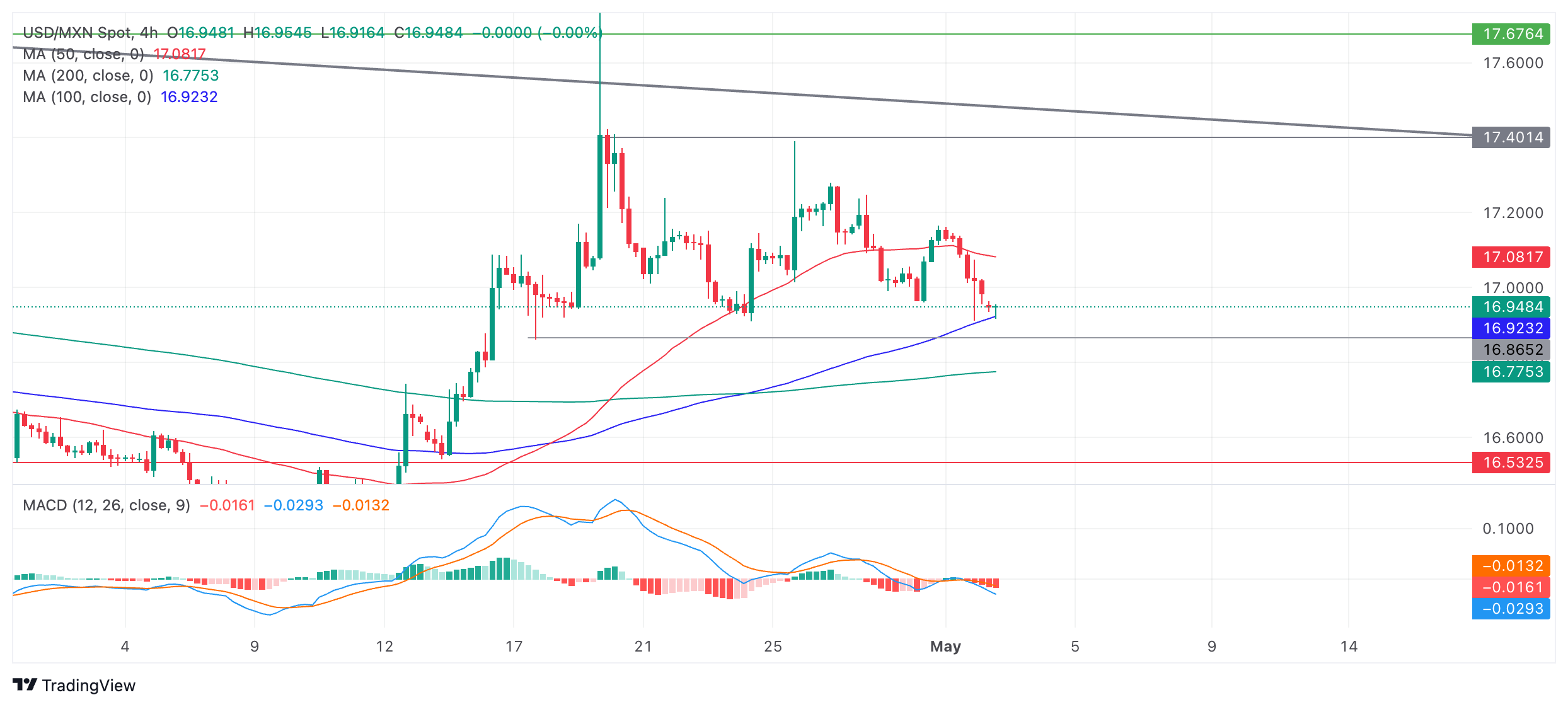Products You May Like
- The Mexican Peso rises as market sentiment lifts following the Federal Reserve meeting on Wednesday.
- Despite acknowledging inflation remained sticky, the Fed’s Chair Jerome Powell described the need for higher interest rates as “unlikely”.
- The Fed’s decision to reduce its Treasury holdings at a slower pace was taken by markets as a mildly dovish move, possibly weakening the USD.
The Mexican Peso (MXN) trades higher in its key pairs on Thursday as market sentiment gets a lift from a combination of factors, including the US Federal Reserve’s (Fed) decision to maintain an easing bias at its policy meeting on Wednesday, and Crude Oil prices hovering close to seven-week lows.
USD/MXN is trading at 16.93, EUR/MXN at 18.16 and GBP/MXN at 21.24, at the time of publication during the European session.
Mexican Peso gains on positive market sentiment
The Mexican Peso, which is sensitive to risk trends, is seeing gains across the board as market sentiment stays positive on Thursday. The Federal Reserve’s decision to keep interest rates at their current level despite persistently firm inflation in the US; the fact that Federal Reserve Chairman Jerome Powell considered a further rise in borrowing costs as “unlikely”, and the Fed’s decision to reduce its holdings of US Treasuries at a slower pace – a dovish move – were all factors supporting a positive outlook for markets.
Lower Crude Oil prices, with WTI trading in the mid $79s, were a further positive factor for global risk sentiment as they reduce companies’ transportation and energy costs.
Asian stocks markets traded mixed overnight, with the Nikkei closing down 0.19%, the Shanghai Composite Index closing down 0.26% but Hong Kong’s Hang Seng up by 2.44% and India’s Sensex 0.36% higher, at the time of writing.
Mexican Peso traders now await S&P Global Mexican Manufacturing PMI data for April out at 15:00 GMT for further clues about how well the sector is bearing up under Banxico’s restrictive interest-rate regime.
In March, Mexico’s Manufacturing PMI eased down to 52.2 from 52.3 in February but remained in expansive territory (above 50), as it has done since September 2023.
A substantial decline in the metric could increase the chances of the Banxico reducing interest rates more rapidly than previously expected. This in turn would probably lead to a depreciation of the Mexican Peso, since lower interest rates reduce capital inflows. The opposite would be the case for a substantial rise in the PMI.
Business Confidence for Mexico is also scheduled for release at 12:00 GMT on Thursday. Previously, the metric stood at 54.3.
Technical Analysis: USD/MXN in sideways short-term trend
USD/MXN extends its short-term sideways trend, oscillating between the parameters of a range with a floor at 16.86 and a ceiling at 17.40.
USD/MXN 4-hour Chart
The pair is currently trading close to the range lows.
Given the sideways trend is biased to continue, the next move will probably be an up leg back towards the range highs, however, there are no signs as yet of such a move evolving.
A decisive breakout of the range – either below the floor at 16.86, or the ceiling at 17.40 – would change the directional bias of the pair.
A break below the floor could see further downside to a target at 16.50, followed by the April 9 low at 16.26.
On the other side, a break above the top would activate an upside target first at 17.67, piercing a long-term trendline and then possibly reaching a further target at around 18.15.
A decisive break would be one characterized by a longer-than-average green or red daily candlestick that pierces above or below the range high or low, and that closes near its high or low for the period; or three green/red candlesticks in a row that pierce above/below the respective levels.
Risk sentiment FAQs
In the world of financial jargon the two widely used terms “risk-on” and “risk off” refer to the level of risk that investors are willing to stomach during the period referenced. In a “risk-on” market, investors are optimistic about the future and more willing to buy risky assets. In a “risk-off” market investors start to ‘play it safe’ because they are worried about the future, and therefore buy less risky assets that are more certain of bringing a return, even if it is relatively modest.
Typically, during periods of “risk-on”, stock markets will rise, most commodities – except Gold – will also gain in value, since they benefit from a positive growth outlook. The currencies of nations that are heavy commodity exporters strengthen because of increased demand, and Cryptocurrencies rise. In a “risk-off” market, Bonds go up – especially major government Bonds – Gold shines, and safe-haven currencies such as the Japanese Yen, Swiss Franc and US Dollar all benefit.
The Australian Dollar (AUD), the Canadian Dollar (CAD), the New Zealand Dollar (NZD) and minor FX like the Ruble (RUB) and the South African Rand (ZAR), all tend to rise in markets that are “risk-on”. This is because the economies of these currencies are heavily reliant on commodity exports for growth, and commodities tend to rise in price during risk-on periods. This is because investors foresee greater demand for raw materials in the future due to heightened economic activity.
The major currencies that tend to rise during periods of “risk-off” are the US Dollar (USD), the Japanese Yen (JPY) and the Swiss Franc (CHF). The US Dollar, because it is the world’s reserve currency, and because in times of crisis investors buy US government debt, which is seen as safe because the largest economy in the world is unlikely to default. The Yen, from increased demand for Japanese government bonds, because a high proportion are held by domestic investors who are unlikely to dump them – even in a crisis. The Swiss Franc, because strict Swiss banking laws offer investors enhanced capital protection.

